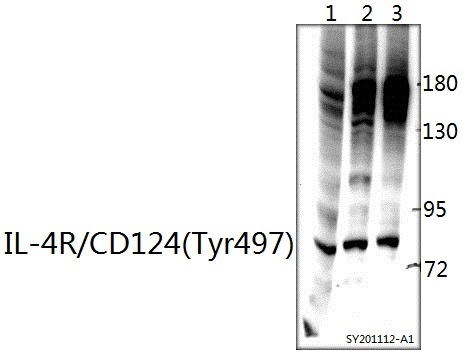Product Name :
IL-4R/CD124(Tyr497) polyclonal antibody Background :
The IL-2 receptor is a multicomponent complex consisting of three subunits, α,β and γ, each of which is required for high affinity binding of IL-2. The α chainfunctions primarily in binding IL-2, whereas the β and γ chains contribute toIL-2 binding and are essential to IL-2-induced activation of signaling pathwaysleading to T cell growth. Both IL-4R and IL-7R were initially described as single chain, high-affinity ligand-binding cytokine receptors. However, it is nowwell established that the IL-2Rγ chain functions as a second subunit of thehigh affinity IL-4R and IL-7R receptors. Consequently, the originally describedsubunits of these latter receptors are now referred to as IL-4Rα and IL-7Rα,respectively, while the common subunit is referred to as γc. Although the common γ chain enhances ligand binding in these three cytokine receptors, ithas no capacity to bind these ligands on its own. There is evidence that theγc chain is also a subunit of IL-13R. Product :
Rabbit IgG, 1mg/ml in PBS with 0.02% sodium azide, 50% glycerol, pH7.4. Storage&Stability :
Store at 4°C short term. Aliquot and store at -20°C long term. Avoid freeze-thaw cycles. Specificity :
IL-4R/CD124(Tyr497) polyclonal antibody detects endogenous levels of HIST1H3A protein. Immunogen :
Synthetic peptide, corresponding to Human IL-4R/CD124(Tyr497). Conjugate :
Unconjugated Modification :
Unmodification
IL-4R/CD124(Tyr497) polyclonal antibody Background :
The IL-2 receptor is a multicomponent complex consisting of three subunits, α,β and γ, each of which is required for high affinity binding of IL-2. The α chainfunctions primarily in binding IL-2, whereas the β and γ chains contribute toIL-2 binding and are essential to IL-2-induced activation of signaling pathwaysleading to T cell growth. Both IL-4R and IL-7R were initially described as single chain, high-affinity ligand-binding cytokine receptors. However, it is nowwell established that the IL-2Rγ chain functions as a second subunit of thehigh affinity IL-4R and IL-7R receptors. Consequently, the originally describedsubunits of these latter receptors are now referred to as IL-4Rα and IL-7Rα,respectively, while the common subunit is referred to as γc. Although the common γ chain enhances ligand binding in these three cytokine receptors, ithas no capacity to bind these ligands on its own. There is evidence that theγc chain is also a subunit of IL-13R. Product :
Rabbit IgG, 1mg/ml in PBS with 0.02% sodium azide, 50% glycerol, pH7.4. Storage&Stability :
Store at 4°C short term. Aliquot and store at -20°C long term. Avoid freeze-thaw cycles. Specificity :
IL-4R/CD124(Tyr497) polyclonal antibody detects endogenous levels of HIST1H3A protein. Immunogen :
Synthetic peptide, corresponding to Human IL-4R/CD124(Tyr497). Conjugate :
Unconjugated Modification :
Unmodification
-
 Western blot (WB) analysis of IL-4R/CD124(Tyr497) polyclonal antibody at 1:2000 dilution Lane1:HepG2 whole cell lysate(40ug) Lane2:MCF-7 whole cell lysate(40ug) Lane3:HCT116 whole cell lysate(40ug)
Western blot (WB) analysis of IL-4R/CD124(Tyr497) polyclonal antibody at 1:2000 dilution Lane1:HepG2 whole cell lysate(40ug) Lane2:MCF-7 whole cell lysate(40ug) Lane3:HCT116 whole cell lysate(40ug)
Bioworld Biotech only provide peptides for our antibodies and do not provide additional peptide customization services.
Price/Size :
USD 368/1mg/vial
Tips:
For phospho antibody, we provide phospho peptide(0.5mg) and non-phospho peptide(0.5mg).Describe :
Blocking peptides are peptides that bind specifically to the target antibody and block antibody binding. These peptide usually contains the epitope recognized by the antibody. Antibodies bound to the blocking peptide no longer bind to the epitope on the target protein. This mechanism is useful when non-specific binding is an issue, for example, in Western blotting (WB) and Immunohistochemistry (IHC). By comparing the staining from the blocked antibody versus the antibody alone, one can see which staining is specific; Specific binding will be absent from the western blot or IHC performed with the neutralized antibody.Formula:
Synthetic peptide was lyophilized with 100% acetonitrile and is supplied as a powder. Reconstitute with 0.1 ml DI water for a final concentration of 10 mg/ml.The purity is >90%,tested by HPLC and MS.
Storage:
The freeze-dried powder is more stable. For short time at 2-8°C. For long term storage store at -20°C.
Note :
This product is for research use only (RUO only). Not for use in diagnostic or therapeutic procedures.
 IL-4R/CD124(Tyr497) polyclonal antibody
IL-4R/CD124(Tyr497) polyclonal antibody  Datasheet
Datasheet COA
COA MSDS
MSDS SHIP
SHIP